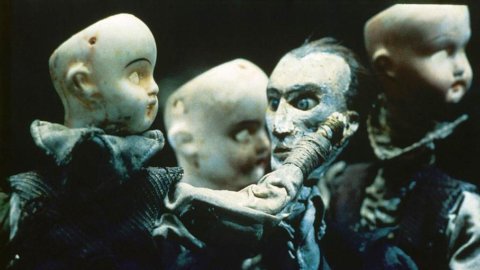30 29 from May to June 2014 the MAN museum in Nuoro presents the exhibition “I'll go for two. The avant-garde of the movement”. The project, curated by Lorenzo Giusti, director of the MAN Museum, and Elena Volpato, curator of the GAM of Turin, responsible for the Film and Artist Video Collection, explores, through a cross-section that from the origins of animated cinema reaches the present day , one of the most fascinating aspects of animation works, that possibility cherished by many artists and filmmakers of using filmic movement as a magical ritual that gives life to the drawing line, the silhouette, the puppet or the photographic image.
The creative imagination, properly demiurgic, which is often underlying the drawing and the representation through figures, takes on the bewitching features of the spell through the movement and the musical rhythm, of a life that is a dance of the imagination. It is no coincidence that artists and film-makers, in approaching the various techniques of animation, often focus on the body image and link to it evocations of the figure of Frankenstein, the Golem or the robot, and artificial birth in general of a body, as if they wanted to repeat in the mythical tale their own power as animators: to give soul to the inanimate.
The works on display therefore offer the possibility of a historical journey in animation, experimental and artistic, through the image of the body, its construction and its "montage". When animation is based on drawing, everything seems to arise from a line, as in the pioneering Fantasmagorie by Émile Cohl (1908) or in Lifeline (1960) by Ed Emshwiller, where the continuous white line envelops itself in knots of material which gradually little become organic arabesque mixing with the photographic image of a dancer's body. Or as in George Griffin's Head (1975), where the basic shape of the face and the artistic tradition of the self-portrait are stripped of any realistic detail and then unexpectedly revived with emotional expressiveness and psychological nuances rendered pictorially.
In other works the drawing leaves room for sculpture and the myth of Pygmalion connected to it, as in the case of Jan Svankmejer who in Darkness Light Darkness (1990) shows a body capable of shaping itself, starting from the two hands, closed in a room , in which all the limbs that will be composed in units flow in sequence. Svankmejer's two hands have an antecedent in the surrealism of Alexeieff and Parker with The Nose (1963), where single, rebellious and independent limbs claim for themselves the power of the vital spell, and seem to find a recent development in some works by Nathalie Djurberg and Hans Berg.
The story of Frankenstein explicitly relives in Len Lye's film, Birth of a robot (1936) and again in Street of Crocodiles (1986), by the Quay Brothers, or in Max Almy's video, The Perfect Leader (1983), where to be artificially built, it is not a creature destined to serve its creator, as with Frankenstein and the Golem, but it is the future political leader who is programmed on the computer so that his dictatorial ferocity reflects the society that wanted and created him.
Other works represent the body as a place of construction, not of single identity, but of social identity. This is the case of the famous L'idée (1932) by Berthold Bartosh, but also, in a different way, of the works of William Kentridge, in which the pain of the masses leaves traces of black dust on the blank pages of history in front of the immodest wet bodies from the blue water of the rich tycoons. This is the case of the silhouettes of Kara Walker, also black against a white background, tortured and raped by colonial ferocity.
Finally, it is dance, the ultimate expression of beauty in movement, which allows us to show the magic of the animated body in the most diverse places of thought and imagination: in Segundo de Chomón's Easter Eggs (1907), in Fernand Léger's Ballet Mécanique, where machine and body tend to merge into a single moving subject, in the absolute space of McLaren's Pas de deux, in the astrological night of Maya Deren's The Very Eye of Night (1958) or in the two-dimensional universe of Robin Rhode's drawing, where body and design meet on a single plane of reality and dream.
The exhibition is completed by the works of Claudio Cintoli (Più, 1964), in which the aesthetic matrix of Pop Art disarticulates the identity of the body in clothes and advertising products; by Stan Vanderbeek (After Laughter, 1982), where the movement of the body in space becomes modification through time, as in a phylogeny of the human, and by Claus Holtz & Harmut Lerch (Portrait Kopf 2, 1980) in which the superimposed animation of faces and heads leads back, in an anti-Lombrosian path, to an original unity of the human trait. Finally, the most recent works by Diego Perrone (Totò nudo, 2005) where the icon of Totò is decomposed and recomposed with a mechanism that does not forget the actor's ability to become a puppet, an inanimate body, and Noa Gur (White Noise, 2012) whose linguistic essentiality ideally closes the path, restoring the ancient root of drawing to the animation of the body: the capture, through the simple technique of the imprint, of an individual and his vital breath.





